The US Army’s aim is to develop an 18-kilowatt laser for the M1131 Stryker Fire Support Vehicle (FSV) by 2018. The FSV is the vehicle that calls for friendly artillery, so it sort of makes sense that it would be responsible for shooting down enemy artillery. It has a thermal imager/day camera that could help it spot drones, and four radios to monitor communications traffic for drone reports. In addition to the laser weapon the FSV will have a electronic jammer to jam drone control signals. The Stryker laser weapon could be operational in as little as 11 months.
Boeing is upgrading the Stryker mounted laser to 5 kilowatts for testing early in 2017.
8 wheel Stryker with 5 kilowatt laser
Solid state and liquid lasers will make combat lasers more compact and more viable on the battlefield.
The US Army is planning to deploy laser weapons able to protect Forward Operating Bases (FOB) by rapidly incinerating and destroying approaching enemy drones, artillery rounds, mortars and cruise missiles.
The emerging weapons are being engineered into a program called Indirect Fire Protection Capability, or IFPC Increment 2. Through this program, the Army plans to have lasers to protect forward bases by 2023 as part of an integrated system of technologies, sensors and weapons designed to thwart incoming attacks.
The Army plans to increase strength of the lasers on tactical trucks up to 100 Kilowatts.
Lockheed is upgrading the 10 kiloWatts laser on this large truck to 60 kiloWatts

Brian Wang is a Futurist Thought Leader and a popular Science blogger with 1 million readers per month. His blog Nextbigfuture.com is ranked #1 Science News Blog. It covers many disruptive technology and trends including Space, Robotics, Artificial Intelligence, Medicine, Anti-aging Biotechnology, and Nanotechnology.
Known for identifying cutting edge technologies, he is currently a Co-Founder of a startup and fundraiser for high potential early-stage companies. He is the Head of Research for Allocations for deep technology investments and an Angel Investor at Space Angels.
A frequent speaker at corporations, he has been a TEDx speaker, a Singularity University speaker and guest at numerous interviews for radio and podcasts. He is open to public speaking and advising engagements.




